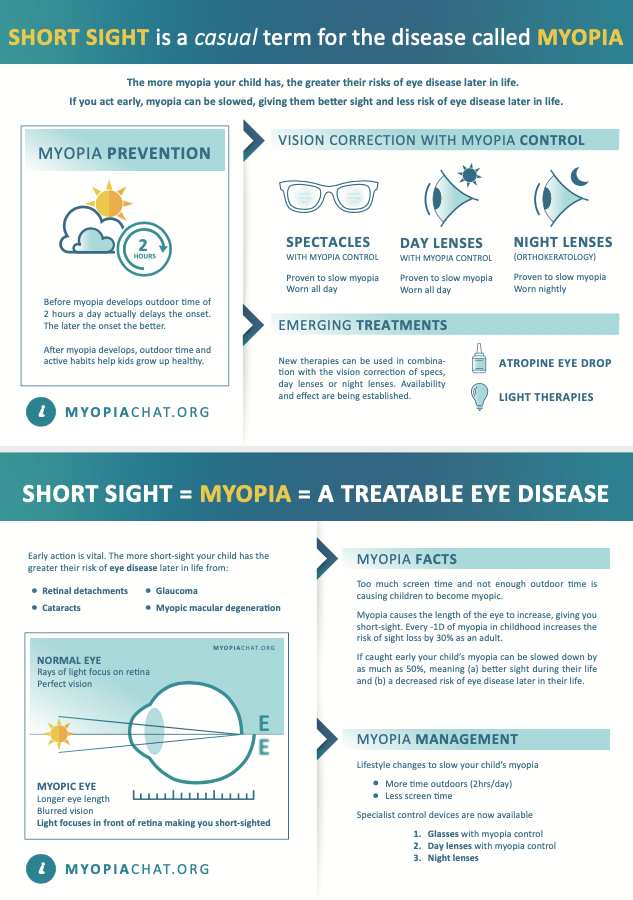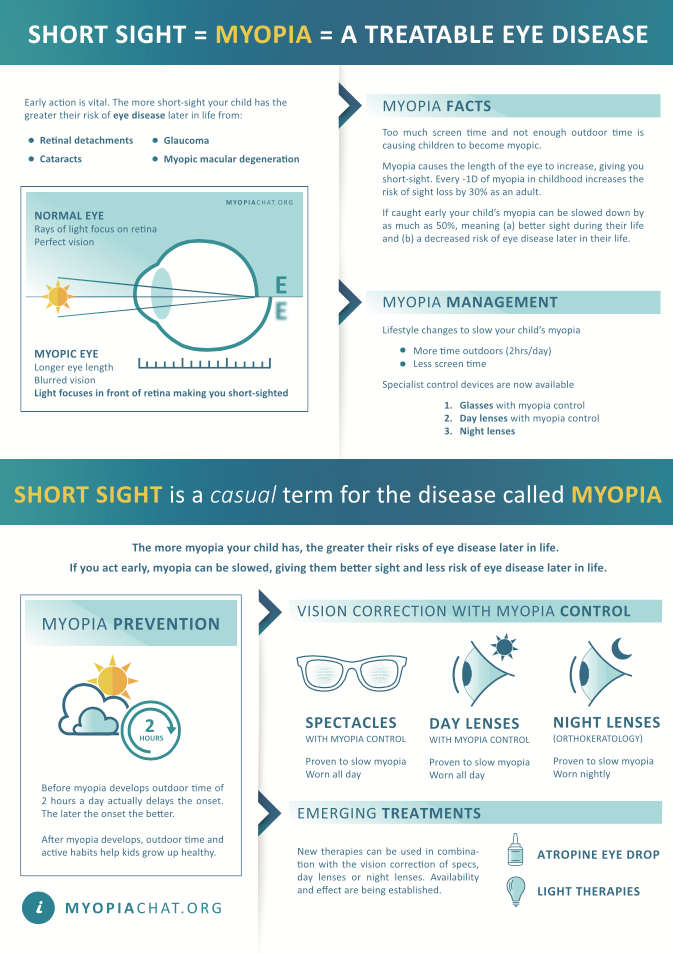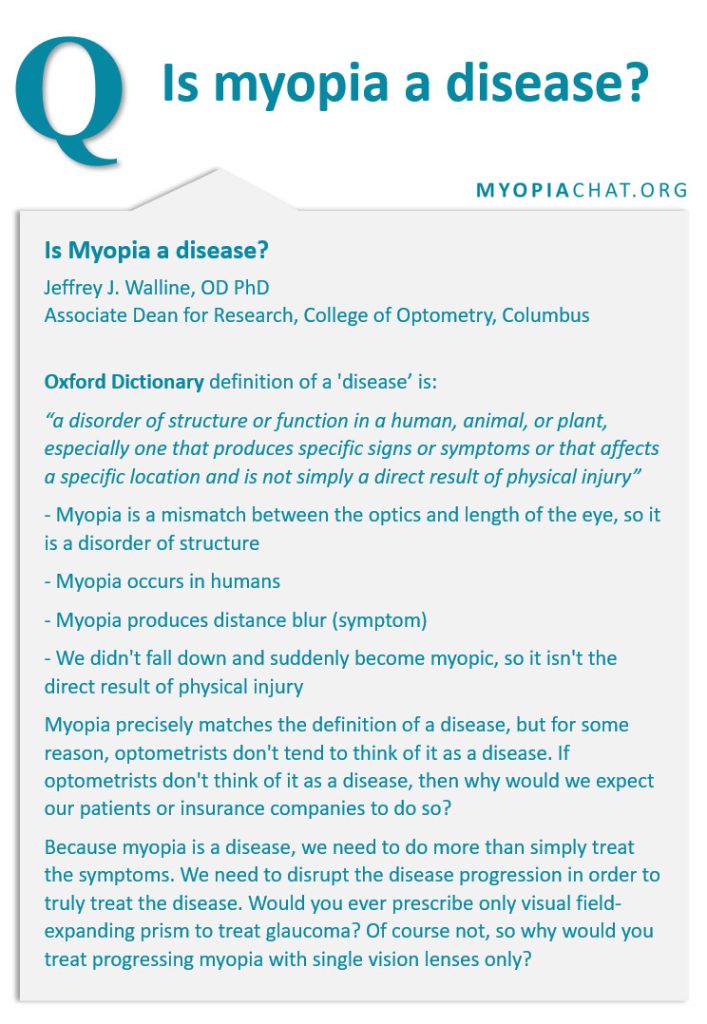Infographics - Download or Order
Articles
Brien Holden Institute: Prevalence: 50% of the world myopic by 2050
American Academy of Ophthalmology: Myopia is a significant, prevalent disease in children with increasing rates of progression.
Is Myopia a Disease?
Jeffrey J. Walline, OD PhD, Associate Dean for Research, College of Optometry, Columbus
Oxford Dictionary definition of a ‘disease’ is:
a disorder of structure or function in a human, animal, or plant, especially one that produces specific signs or symptoms or that affects a specific location and is not simply a direct result of physical injury.
– Myopia is a mismatch between the optics and length of the eye, so it is a disorder of structure
– Myopia occurs in humans
– Myopia produces distance blur (symptom)
– We didn’t fall down and suddenly become myopic, so it isn’t the direct result of physical injury
Myopia precisely matches the definition of a disease, but for some reason, optometrists don’t tend to think of it as a disease. If optometrists don’t think of it as a disease, then why would we expect our patients or insurance companies to do so?
Because myopia is a disease, we need to do more than simply treat the symptoms. We need to disrupt the disease progression in order to truly treat the disease. Would you ever prescribe only visual field-expanding prism to treat glaucoma? Of course not, so why would you treat progressing myopia with single vision lenses only?
Additional
The more myopia your child has, the greater their risks of eye disease later in life.
Bullimore, Mark A. MCOptom, PhD, FAAO1*; Brennan, Noel A. MScOptom, PhD, FAAO. Myopia Control: Why Each Diopter Matters. Optometry and Vision Science 96(6):p 463-465, June 2019. | DOI: 10.1097/OPX.0000000000001367
If you act early, myopia can be slowed, giving them better sight and less risk of eye disease later in life.
Hu Y, Ding X, Guo X, Chen Y, Zhang J, He M. Association of Age at Myopia Onset With Risk of High Myopia in Adulthood in a 12-Year Follow-up of a Chinese Cohort. JAMA Ophthalmol. 2020;138(11):1129–1134. doi:10.1001/jamaophthalmol.2020.3451
Too much indoor time is causing children to become myopic
Huang P, Hsiao Y, Tsai C, et al Protective behaviours of near work and time outdoors in myopia prevalence and progression in myopic children: a 2-year prospective population study British Journal of Ophthalmology 2020;104:956-961.
If caught early your child’s myopia can be slowed down by as much as 50%,
Specs with myopia control technology | 57% reduction in eye growth, 1 year study in Europeans.
A comparison of myopia control in European children and adolescents with defocus incorporated multiple segments (DIMS) spectacles, atropine, and combined DIMS/atropine. Paolo Nucci, Andrea Lembo, Irene Schiavetti, Rakhee Shah, David Francis Edgar, Bruce John William Evans . Published: February 16, 2023. https://doi.org/10.1371/journal.pone.0281816
Day lenses with myopia control technology | 52% reduction in eye growth
Chamberlain, Paul BSc (Hons)1∗; Peixoto-de-Matos, Sofia C. MSc; Logan, Nicola S. PhD; Ngo, Cheryl MBBS, MMed; Jones, Deborah BSc, FAAO; Young, Graeme PhD, FAAO. A 3-year Randomized Clinical Trial of MiSight Lenses for Myopia Control. Optometry and Vision Science 96(8):p 556-567, August 2019. | DOI: 10.1097/OPX.0000000000001410
Night Lenses 63% reduction in eye growth, meta-analysis of multiple studies 2012 to 2019
Li, X., Xu, M., San, S. et al. Orthokeratology in controlling myopia of children: a meta-analysis of randomized controlled trials. BMC Ophthalmol 23, 441 (2023). https://doi.org/10.1186/s12886-023-03175-x
Before myopia develops outdoor time of 2 hours a day actually delays the onset.
Ho CL, Wu WF, Liou YM. Dose-Response Relationship of Outdoor Exposure and Myopia Indicators: A Systematic Review and Meta-Analysis of Various Research Methods. Int J Environ Res Public Health. 2019 Jul 21;16(14):2595. doi: 10.3390/ijerph16142595. PMID: 31330865; PMCID: PMC6678505.
Red light therapy emerging as effective
Wang F, Peng W, Jiang Z. Repeated Low-Level Red Light Therapy for the Control of Myopia in Children: A Meta-Analysis of Randomized Controlled Trials. Eye Contact Lens. 2023 Oct 1;49(10):438-446. doi: 10.1097/ICL.0000000000001020. Epub 2023 Aug 8. PMID: 37565498.



